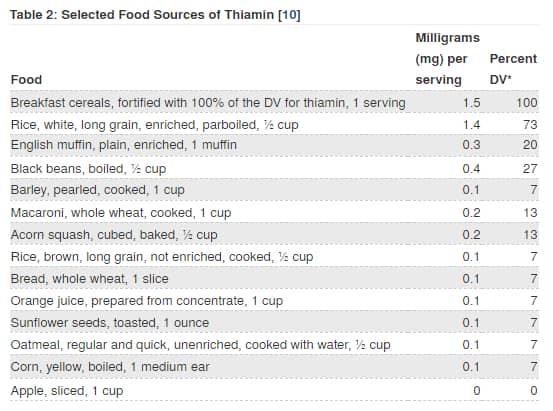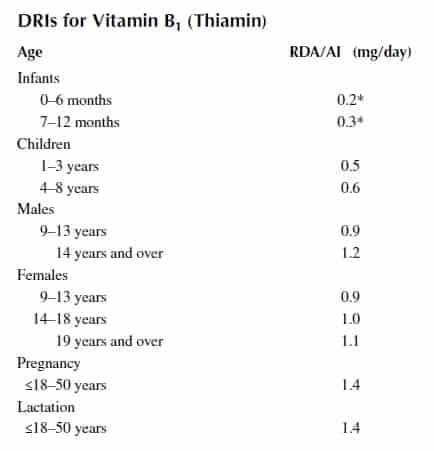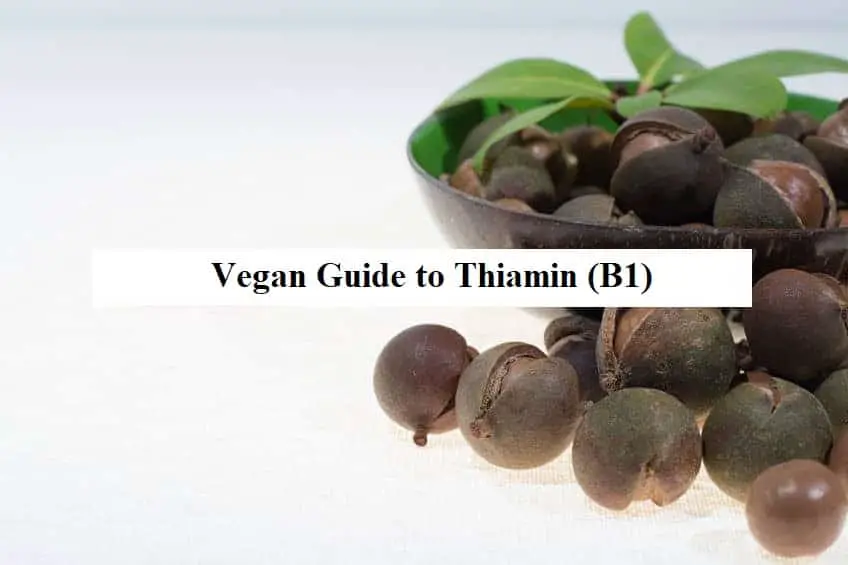What we’ll do here is cover some basic information about thiamin or vitamin B1 as relates to plant-based eating.
First, I’ll answer some common questions for those of you who are in a rush:
- Is thiamin (vitamin B1) vegan? Yes, unlike vitamin D (check out the article here) and vitamin B12, thiamin is found in numerous plant foods. As for supplements, thiamin (typically mononitrate or hydrochloride in pill form) can be derived from animals but tends to be produced via chemical synthesis.20 So, it’s typically considered vegan.
- What are some vegan sources of thiamin? Common vegan sources of thiamine include fortified bread and cereals, legumes, margarine, rice, soy products, nutritional yeast, orange juice, veggie burgers and other alternative meats (Morningstar Farms, Worthington, etc.).1,2(See the chart below for more examples)
- Are vegans commonly deficient in thiamin? No. According to NIH, those at risk for thiamin deficiency include the alcohol dependent, older adults, people with HIV/AIDS, diabetics, and people who’ve undergone bariatric surgery.3
- Vegan foods highest in thiamin: nutritional yeast, vegan sausage, margarine spread, and fortified cereals. If you’re looking for healthier non-animal sources (other than yeast), fortified whole wheat bread is a great option.1
- Are thiamin mononitrate and thiamin hydrochloride vegan? Yes.
What we’ll do next is take a closer look at the sources of thiamin as well as some other basic info. We’ll cover its functions and the unique ways in which plant-based diets can lead to deficiency.
Overview and Functions
Thiamin is one of the water-soluble vitamins. The need for this nutrient was first noticed in the late 1800s by a Dutchman, C. Eijkman, when it was recognized that fowl given a diet of polished rice (rice without the outer germ and bran layers) started to develop neurologic problems—what’s now known as beriberi which we’ll cover a bit further down in the article.4
The functions of thiamin include:5
- ATP production (a coenzyme role)
- Pentose and NADPH (also a coenzyme function)
- Membrane and nerve conduction (non-coenzyme capacity)
Coenzyme Roles
Thiamin in food comes in two forms: the free (nonphosphorylated) form as found in plant foods and various phosphorylated forms found in animal foods.
The phosphorylated forms include:6
- Thiamin diphosphate (TDP) aka thiamin pyrophosphate (TPP)—95% of thiamin present in animal foods.
- Other phosphorylated forms found in lesser amounts (5%)—thiamin monophosphate (TMP) and thiamin triphosphate (TTP).
It’s free thiamin that’s absorbed, at which point most is taken up by the liver and then phosphorylated via thiamin pyrophosphokinase to its coenzyme form TDP. About 80% of the total body thiamin exists as TDP.5
ATP Production
As TDP, thiamin functions as a coenzyme in energy transformation (ATP generation) in a few enzyme complexes with fancy names like:7
- The α-ketoglutarate dehydrogenase complex
- The branched-chain α-keto acid dehydrogenase complex
- The pyruvate dehydrogenase complex—alongside riboflavin (FAD), niacin (NAD +), and pantothenic acid (CoA-SH)
The Synthesis of Pentoses and NADPH
Do you remember the hexose monophosphate shunt from high school biology? Me either. It’s the pathway by which sugars are interconverted.
It’s essential for generating pentoses for nucleic acid synthesis and for synthesizing NADPH, which is needed for a number of reasons—fatty acid synthesis, etc.
Well, thiamin in the form of TDP functions as a component of a key enzyme in this pathway.12,9
So, yeah it’s kind of important.
Noncoenzyme Roles
Membrane and Nerve Conduction
So, above I mentioned TTP—a form of thiamin that’s only found in small amounts in animal foods. You needn’t get it from animal foods as the body can phosphorylate its own.
About 10% of body thiamin is found in the form of TTP. It’s synthesized by TDP-ATP phosphoryl transferase which phosphorylates TDP.5
Anyway, TTP is involved in the function of the nervous system. Hence, why fowl deprived of thiamin developed neurological symptoms. Beriberi is a manifestation of thiamin deficiency as relates to its non-coenzyme functions.
These functions include:9
- Nerve membranes—it’s thought that thiamin activates chloride transport.
- Transmission of nerve impulses via regulating sodium channels
- Phosphorylation of proteins.
Sources
Legumes and Grain Products
Grain products (general)—whole, fortified or enriched:6
- Cereals— 1 Cup of Cheerios® and bran cereal w/raisins both provide about 0.38 mg which is which is 25% of the Daily Value (1.5 mg).
- Bread—1 slice of whole-grain wheat bread provides 0.08 mg of thiamin, while enriched white bread provides 0.11 mg per slice.
- Enriched spaghetti provides 0.29 mg per cup.
- Black beans—these provide around 0.4 mg per cup.
Other Good Sources
- Yeast (a really dense source)
- Wheat germ
- Soy milk
As for supplements, OTC thiamin is found mostly in the form of thiamin hydrochloride or mononitrate salt.
Select Thiamin Sources

Source: adapted from Office Of Dietary Supplements – Thiamin https://ods.od.nih.gov/factsheets/Thiamin-HealthProfessional/
Recommended Daily Allowance (Needs)
Recommendations (RDA) for thiamin intake are based on metabolic studies, enzyme activity, and thiamin intake data.
The RDA for adults is 1.2 mg/day and 1.1 mg/day for men and women, respectively.10
Differences between men and women are based upon body size and energy needs.
Needs go up a bit for pregnancy and lactation increasing to 1.4 mg/day.3

Source: Micronutrients in Health and Disease. Kedar Prasad – Crc – 2011
Deficiency Symptoms
Related to Its Coenzyme Roles
As mentioned, thiamin plays a role in various enzyme complexes.
The α-ketoglutarate
This leads to a build-up of both branched-chain AAs and their α-keto acids which accumulate in the blood and other body fluids.
These changes are characteristic of maple syrup urine disease (MSUD), which is an inborn error of metabolism resulting from insufficient activity of the branched-chain α-keto acid dehydrogenase complex.8
Non-Coenzyme Roles (Nervous System)
Beriberi (
Dry Beriberi
Found mostly in adults. It results from a chronic low thiamin intake—especially with a high intake of carbohydrate.
It’s characterized by: 11
- Muscle weakness and wasting, specifically in the lower extremities
- Peripheral neuropathy. The neuropathy component mostly affects the distal parts of the limbs (i.e., ankles, feet, hands, and wrists).
Wet Beriberi
This form of thiamin deficiency results in more extensive CV system involvement compared to dry beriberi. 11
Cardiovascular-related symptoms include: 11
- Cardiomegaly (enlarged heart)
- Tachycardia (rapid heartbeat)
- Right-side heart failure (RSHF) with respiratory involvement
- Peripheral edema (typically of the lower limbs).
Acute Beriberi
This kind occurs mostly in infants. It’s associated with:
- Anorexia
- Vomiting
- Altered heart rate
- Cardiomegaly (abnormally enlarged heart)
- Lactic acidosis as thiamin is needed to convert pyruvate to acetyl-CoA. In the absence of thiamin, pyruvate gets converted to lactic acid instead.
The Vegan Diet and Thiamin Deficiency
Again, not a huge area of concern, but there are ways in which a 100% plant-based diet could uniquely contribute to thiamin deficiency.
Plant-Based Anti-Thiamin Factors

Anti-thiamin factors prevent the absorption of thiamin. This is not a problem unique to plant foods. For example, thiaminases are enzymes found in raw fish that catalyze the destruction of the vitamin.
Polyhydroxyphenols
Polyhydroxyphenols—namely, tannic, chlorogenic, and caffeic acids—are compounds that inactivate thiamin by destroying its ring structure. This process can be facilitated by the presence of certain minerals such as calcium and magnesium.
Primary sources of polyhydroxyphenols include:
- Coffee
- Tea
- Betel nuts
- Certain fruits and vegetables—blueberries, black currants, red cabbage, and Brussels sprouts
Tip: ensure high intakes of vitamin C. These compounds are thermostable, thus are not destroyed by heat. However, thiamin destruction can be prevented by the presence of reducing compounds like ascorbic acid and vitamin C—it should be easy given that fruits and veggies come prepackaged with these compounds.5
Relative Abundance in Animal Foods
In food, thiamin is usually present in only small amounts overall—though it’s widely distributed. However, animal food sources do tend to contain much more than plant sources.
Meats (especially pork) are the most rich sources of this vitamin. For example, pork loin provides around 0.65 mg of thiamin per 3-oz serving. Beef and beef liver has about 0.07 mg and 0.26 mg per 3-oz serving, respectively. Salmon contains around 0.23 mg per 3 oz.
For this reason, intuitive eating without supplementation on an omnivorous diet would be less likely to result in deficiency.
Just make sure to include plenty of the foods listed under sources and you’ll be fine. A multivitamin wouldn’t hurt either.
Nutrient Loss
This one’s not at all unique to plant-based diets, but it’s worth mentioning here. Thiamin is destroyed by heat and in an alkaline environment (pH of 8 or higher).6
It’s also water-soluble and will be lost to leaching if thiamin-rich foods are cooked in water.
References
- SELF Nutrition Data. https://nutritiondata.self.com/foods-000108000000000000000.html
- SELF Nutrition Data. https://nutritiondata.self.com/facts/cereal-grains-and-pasta/5747/2
- Office Of Dietary Supplements – Thiamin https://ods.od.nih.gov/factsheets/Thiamin-HealthProfessional/
- Eijkman, C. (1897). “Eine Beriberiähnliche Krankheit der Hühner”. Archiv für pathologische Anatomie und Physiologie und für klinische Medizin. 148 (3): 523–532.
- Gropper, Sareen S.; Smith, Jack L.. Advanced Nutrition and Human Metabolism (Page 320).
- Gropper, Sareen S.; Smith, Jack L.. Advanced Nutrition and Human Metabolism (Page 319).
- Gropper, Sareen S.; Smith, Jack L.. Advanced Nutrition and Human Metabolism (Page 321).
- J Dancis, J Hutzler, and R P Cox. Maple syrup urine disease: branched-chain keto acid decarboxylation in fibroblasts as measured with amino acids and keto acids. Am J Hum Genet. 1977 May; 29(3): 272–279.
- Gropper, Sareen S.; Smith, Jack L.. Advanced Nutrition and Human Metabolism (Page 323).
- Food and Nutrition Board. Dietary Reference Intakes for Thiamin, Riboflavin, Niacin, Vitamin B6 , Folate, Vitamin B12 , Pantothenic Acid, Biotin, and Choline. Washington, DC: National Academy Press. 1998 pp. 58–86.
- Gropper, Sareen S.; Smith, Jack L.. Advanced Nutrition and Human Metabolism (Page 324).
- Gropper, Sareen S.; Smith, Jack L.. Advanced Nutrition and Human Metabolism (Page 322).
- Jose L. Revuelta, Ruben M. Buey, Rodrigo Ledesma‐Amaro, and Erick J. Microbial biotechnology for the synthesis of (pro)vitamins, biopigments and antioxidants: challenges and opportunities. Microb Biotechnol. 2016 Sep; 9(5): 564–567.

